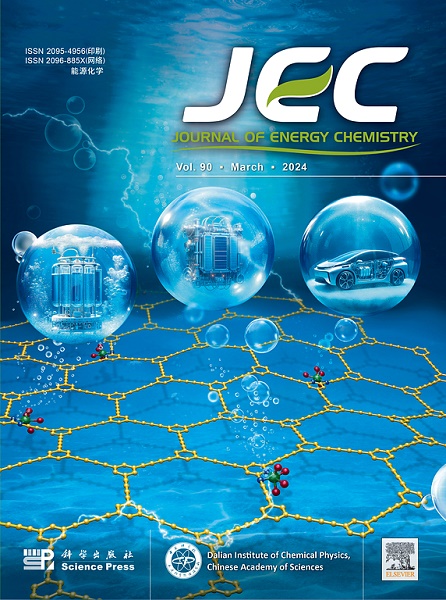Promoting CO2 electroreduction to C2H4 product by promoting water molecules activation on MgO/CuO catalyst
IF 13.1
1区 化学
Q1 Energy
引用次数: 0
Abstract
Electrocatalytic CO2 reduction reaction (CO2RR) to ethylene (C2H4) represents a promising approach to reducing CO2 emissions and producing high-value chemicals. The ethylene productivity is always limited by the slow reaction kinetics and the high-performance catalysts are significantly desired. Many efforts have been made to develop a catalyst to activate CO2 molecules. However, as another reactant, H2O activation does not receive the attention it deserves. In particular, slow H2O dissociation kinetics limit the rate of proton supply, severely impairing the production of C2H4. Here, we designed a MgO-modified CuO catalyst (MgO/CuO), which can promote H2O dissociation and enhance CO2 adsorption at the same time to realize the efficient ethylene production. The optimal catalyst exhibits a Faraday efficiency for C2H4 reached 54.4% at −1.4 V vs. RHE in an H-cell, which is 1.4 times that of pure CuO (37.9%), and it was further enhanced to a 56.7% in a flow cell, with a high current density of up to 535.9 mA cm−2 at −1.0 V vs. RHE. Experimental and theoretical calculations show that MgO/CuO plays a bifunctional role in the CO2RR, which facilitates the adsorption and activation of CO2 by CuO and simultaneously accelerates H2O dissociation by MgO doping. The in situ XRD experiments demonstrate that the introduction of MgO protects CuO active phase to avoid overreduction and preserves the active centers for CO2RR. In combination with in situ FTIR and DFT calculations, the protonation process from *CO to *COH and asymmetric C–C coupling step are promoted by the enhanced water activation and proton coupling on MgO/CuO. This work provides new insights into the CO2 and H2O coactivation mechanism in CO2RR and a potential universal strategy to design ethylene production electrocatalysts.

求助全文
约1分钟内获得全文
求助全文
来源期刊

Journal of Energy Chemistry
CHEMISTRY, APPLIED-CHEMISTRY, PHYSICAL
CiteScore
19.10
自引率
8.40%
发文量
3631
审稿时长
15 days
期刊介绍:
The Journal of Energy Chemistry, the official publication of Science Press and the Dalian Institute of Chemical Physics, Chinese Academy of Sciences, serves as a platform for reporting creative research and innovative applications in energy chemistry. It mainly reports on creative researches and innovative applications of chemical conversions of fossil energy, carbon dioxide, electrochemical energy and hydrogen energy, as well as the conversions of biomass and solar energy related with chemical issues to promote academic exchanges in the field of energy chemistry and to accelerate the exploration, research and development of energy science and technologies.
This journal focuses on original research papers covering various topics within energy chemistry worldwide, including:
Optimized utilization of fossil energy
Hydrogen energy
Conversion and storage of electrochemical energy
Capture, storage, and chemical conversion of carbon dioxide
Materials and nanotechnologies for energy conversion and storage
Chemistry in biomass conversion
Chemistry in the utilization of solar energy
 求助内容:
求助内容: 应助结果提醒方式:
应助结果提醒方式:


